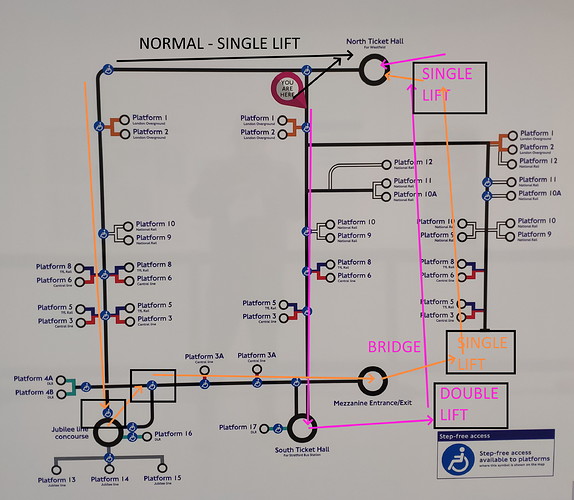Hello everyone
We’re pleased to announce the release of two new sources of accessibility data that in combination with existing TfL Open Data sources allows the calculation of which step-free routes are possible across the TfL network. This coincides with the release of new step-free lift status functionality in the TfL Go mobile app.
The scope of the two data sources includes London Underground, DLR, TfL Rail and London Overground stations.
Step-Free Disruptions API
This API returns a list of the step-free lift routes at stations across the TfL network that are not currently available. The step-free lift routes are identified by codes for the start and stop areas within stations that the lifts connect between. The stations in question are identified by NaPTAN codes. Step-free lift routes are defined as those that are necessary for wheelchair users to access transport modes at a station. They include journeys between a station entrance and a platform, as well as journeys from one platform or another. The API uses TfL operational data and updates once every minute. It can be found at: https://api.tfl.gov.uk/Disruptions/Lifts/
lrad-v2
lrad-v2 is an xml file containing baseline accessibility information about all stations on the TfL network. It complements the Step-Free Disruptions API in that it identifies the step-free lift routes at each station via their start and stop area codes within a station. In addition to this it relates lift routes to the station topology, specifically the entrances and platforms that those lift routes connect between, including the names of the lines and their direction at platforms. lrad-v2 does not currently use NaPTAN codes but the Station Name attribute it uses can be cross referenced to NaPTAN codes using TfL’s Stop Point API which can be found here: https://api.tfl.gov.uk/StopPoint/HUBLBG
lrad-v2 also contains other accessibility data about stations including but not limited to: toilet location, presence of manual boarding ramps and level access humps on platforms, the size of gaps between trains and platforms and accessible interchanges to other modes of transport such buses or National Rail.
As well as an xml file, lrad-v2 has an accompanying xsd file and a technical specification pdf which can all be found in the ‘Accessibility and toilets’ section on this page: Our open data - Transport for London
The lrad-v2 xml file will be overwritten when the values in the dataset change. The xml, xsd and tech spec files will be versioned when the attributes or structure in the dataset change.
The lrad-v2.xml dataset replaces the elrad.xml dataset found at the following locations:
https://tfl.gov.uk/tfl/syndication/feeds/step-free-tube-guide.xml
